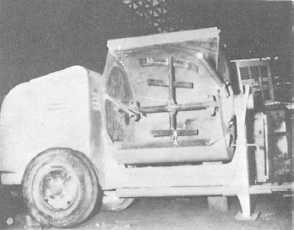Levels are shaped similar to rulers and have vials enclosed in glass. Inside each vial is a bubble of air suspended in either alcohol or oil. When a bubble is located exactly between the two center marks on the vial, the object is either level or plumb, depending on the position in which the mason is using the level. In a level, alcohol is the more suitable since oil is more affected by heat and cold. The term "spirit level" indicates that alcohol is used in the vials. The vials are usually embedded in plaster or plastic so that they remain secure and true. Shorter levels are made for jobs where a longer level will not fit. The most popular of these are 24 and 18 inches long.
In a level constructed of wood, you should occasionally rub a small amount of linseed oil into the wood with a clean cloth. This treatment also stops mortar from sticking to the level. Do not use motor oil as this eventually rots the wed.
STRAIGHTEDGE
A straightedge (figure 8-2, view 3) can be any length up to 16 feet. Thickness can be from 1 1/8 inches to 1 1/2 inches, and the middle portion of the top edge from 6 to 10 inches wide. The middle portion of the top edge must be parallel to the bottom edge. You use a straightedge to extend a level to plumb or level distances longer than the level length.
Other mason's tools and equipment include shovels, mortar hoes, wheelbarrows, chalk lines, plumb bobs, and a 200-foot ball of good-quality mason's line. Be sure to keep wheelbarrows and mortar tools clean; hardened mortar is difficult to remove. Clean all tools and equipment thoroughly at the end of each day or when the job is finished.
A mortar mixing machine (figure 8-3) is used for mixing large quantities of mortar. The mixer consists primarily of a metal drum containing mixing blades mounted on a chassis equipped with wheels for towing the machine from one job site to another. The mixer is powered by either an electric motor or a gasoline engine. After mixing, the mortar is discharged into a mortar box or wheelbarrow, usually by tilting the mixer drum. As with any machine, refer to the manufacturer's operator and maintenance manuals for proper operation. Be sure to follow safety requirements related to mixer operations.
CONCRETE MASONRY
LEARNING OBJECTIVE: Upon completing this section, you should be able to identify the components and requirements of concrete masonry construction.
One of the most common masonry units is the concrete block. It consists of hardened cement and may be completely solid or contain single or multiple hollows. It is made from conventional cement mixes and various types of aggregate. These include sand, gravel, crushed stone, air-cooled slag, coal cinders, expanded shale or clay, expanded slag, volcanic cinders (pozzolan), pumice, and "scotia" (refuse obtained from metal ore reduction and smelting). The term "concrete block" was formerly limited to only hollow masonry units made with such aggregates as sand, gravel, and crushed stone. Today, the term covers all types of concrete block-both hollow and solid - made with any kind of aggregate. Concrete blocks are also available with applied glazed surfaces, various pierced designs, and a wide variety of surface textures.

Figure 8-3.-Mortar mixing machine
Continue Reading